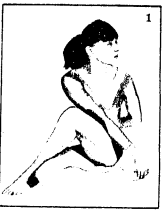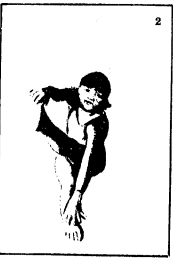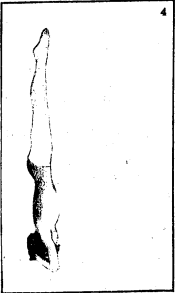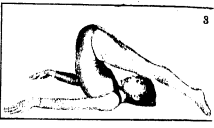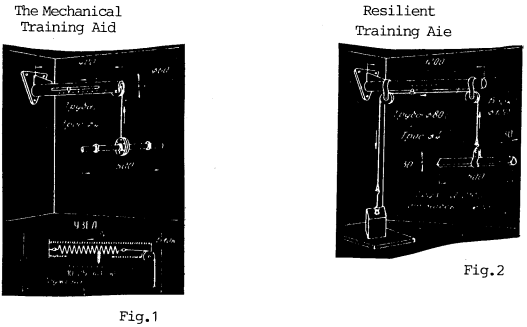When the website was first started, when I spent many hours going through Google trying to find any type of real books written by a person showing them how to grow taller, there was only one books which I thought could be valid based on the authority and credentials of the Author. This book is “School of Height” (Free Download HERE), written by a guy named A.S. Palko, but translated and edited by someone named Michael Yessis.
I would write two posts about this “book”. They are…
In the first post referenced, I did a short outline on what you would find in this “book” if you went through it. However it seems that this document is not the size of a book, because it is very short, in the same size as a scientific paper.
For this post, I wanted to do a complete analysis on everything that is written in this document to see if we can take something away to be used in our everyday regular routines. Like I said in the two previous posts, there are 7 main sections…
The 7 sections are supposed to go…
- General preparation
- Specific flexibility
- Asymmetric exercises
- Nutrition
- Pressure massage
- Breathing and autogenic training
- Training aids
I will write a summary and analysis for each section
Section #1: General Preparation
A few interesting things are found out before the actual “book” starts. The orthopedic surgeon who supposedly wrote the article first name is Anatoly Palko. There seems to be this magazine or maybe professionally peer reviewed journal called Legkava Atletika where an article entitled “So you want to grow a little?” was published.
The first point made is that apparently most people never reach the optimum, maximum adult height or go through the highest level of growth possible. It can be due to vitamin deficiency, injuries, or inflammation. So almost everyone’s possible height potential is never fully reached.
It is said that the spinal cord grows in spurts, at a very random, non linear way. Girls supposed go through the greatest amount of growth between the age of 10-14. For boys, the growth is greatest between the ages of 13-18. Almost everything can halt or decrease the vertical growth of the spinal column or the tubular long bones. The author notes that something known as hypophysis hormone production is important.
Note #1: The chemical compound nicotine has been found to be extremely bad for growth. It is said to “suppress the hypophysis, causes vascular spasms, and slows down the metabolism.”
It is interesting and slightly profound to read that the writer states that normal exercises won’t help in giving someone the height increase they desire. Hanging on bars and jumping will NOT make you taller.
The system that the person has created supposedly has no extraneous information and that the sequence of actions in the program must be followed exactly for the height increase.
The first thing that the writer notes is that a person should increase their range of motion and flexibility. Pay close attention to the lumbar and hip regions. The muscles that you are using should be kept tense while the muscles that you are not using should be kept loose.
For the psychological aspect, the program must be done with
- Persistence
- Consistency
- Purposefulness
- Willpower
The thing that is noted again is that many people will try to grow taller by hanging on a horizontal bar and attaching progressively heavier weights to their legs or ankles trying to stretch out the overall body. This is noted to not produce any results.
The reason this doesn’t work is that the ankles would cause the muscles in the trunk to tense up and contract. Those muscles in the trunk are supposed to be relaxed so that the spinal disks can be given an actual chance to decompress. When the tension in the muscles are relaxed (say through massage or heat therapy) there will be an increase in circulation and the blood supply increases.
The exercise program starts with gymnastics. The main thing we do here is to just get the muscles prepared for higher flexibility exercises.
From this point on, there is a 15 step guide on stretching and flexibility just to make the muscles in the body more flexible and loose. Click and download the PDF file HERE for the 15 step instructions on how to do section #1.
Section #2: Specific Flexibility
The 2nd section is where the more advanced flexibility exercises are. It is important that you focus on mastering how to do the flexibility exercises from the 1st section before moving on to this section. The exercises in this section are supposed to have these benefits which correlate to increased height…
- Loosen the spine
- Strengthen the spinal and trunk muscles
- Enhance Coordination
- Increase the range of movement
- Lengthen the spine including the cervical portion.
These things will increase height and force the person doing them to develop better posture.
The focus is to pay really close attention to posture because it really affects one’s height. If the spine is sagging, the shorter the height. It seems that if the muscles are weak, the spinal column will ‘sit’ or go into a state of dropping down. The writer claims that the loss in height can be as much as 10 cms. A little bit of spinal curvature is okay and natural but one should focus on within curvature limits.
The spinal curvature limits are…
- Cervical Spine – 2-2.5 cm
- Lower Spine – 2.53 cms
The correct way to measure height is to stand in front of the wall and have 5 points of the body touching the wall: heel, calf, buttocks, spine, back of the head.
Again, the writer makes the point that the 2nd section exercises should not be worked on without getting the exercises from the 1st section mastered. The exercises can be done at any time except after meal time up to 1.5-2 hours after eating. Also don’t do the exercises if you feel fatigue, or in chronic or acute illnesses.
The rest of the section is directions on how to perform the stretching exercises to improve flexibility. There are 5 exercises in total. The actual instructions are in the PDF of the file.
Section #3: Asymmetric Exercises
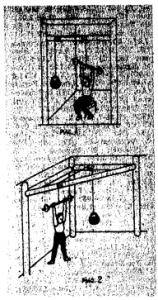 The third section has a training aid which seems to be a device which involves two pulleys. The device is a rope where a weight around 1/3rd the weight of the person is attach on one end and on the other end is a horizontal bar.
The third section has a training aid which seems to be a device which involves two pulleys. The device is a rope where a weight around 1/3rd the weight of the person is attach on one end and on the other end is a horizontal bar.
The pulley can be in any configuration, like in a doorway or corner of a room.
It is noted that this device should not be used until a set of certain exercise is mastered first. It seems that people can gain several cms of height increase from using the machine but they can lose all that increase due to habitual motor pattern from bad posture.
The answer to the affect of losing the gained height which they say is due to automatic muscle reflex in the trunk is to do a special type of exercise known as asymmetrical exercises. The exercises involve combining a certain rhythm with a movements with symmetric parts of the body. they state…
“Systematic workouts teach one to exceed the limits of conditioned reflexes. Having internal control and adapting easily to rhythm changes makes it happen.”
This third set of exercises should be done either after or in parallel with the 2nd set of exercises. The rest of the section is the actual exercise routine that is given on how we should do the exercises. Refer to the PDF about how they are done exactly.
Section #4: Nutrition
I personally don’t wish to put anything in this section. The nutrition main point is that one should focus on eating nutritious vegetables and meat which have the right amount of vitamins and proteins. There are suggestions on the types of vegetable, and even recipe guides. I don’t think this section is very helpful for the person who wants to grow taller.
Section #5: Pressure Massage
The 5th section involves doing a type of massage involving using rugs, needles, and pins. The author supposedly developed a method for massage involving a piece of plastic and needles.
The idea is to have the needles already embedded in a fatty skin plastic material. It should last more than 15 minutes. Before massage, you should wash the area of skin and cover it with vaseline.
There is a 9 step method in the 5th section on how you should take the plastic rug and rub it on your legs.
Section #6: Breathing and Autogenic Training
This section involves the idea that if we focus on improving our breathing combined with something called autogenic training, we can decrease the amount of tension in our bodies. First that is a small biology lesson, on the function of the alveoli of the lungs. There is supposed to be 700 million of these alveoli and they combined together form about 100 sq meters. The alveoli is supposed to be where Oxygen will be coming from and where CO2 will be excreted (I am not sure how accurate this information is at this time. It might be wrong).
There is supposed to be two types of breathing based on the level of duration between inhalation and exhalation. They are 1. mobilizing and 2. sedative.
- Sedative Breathing – Involves longer exhalation
- Stimulating Breathing – Involves longer inhalation
Lie down for the breathing exercises if possible. Put the hand on the stomach. You want the breathing to be diaphragmatic. Get a stopwatch of count in your head.
Practice in a place with fresh air or is well ventilated.
The whole idea behind the breathing is that by using the sedative breathing way, you can voluntarily relax the muscles and possibly increase the body’s flexibility.
So what about the autogenic training?
It seems that using goal directed active con stage inhalation is deeper and sciousness is a powerful resource for tapping the bodys physical reserves. This training is not physical but mental. Autogenic training is supposed to be a real scientific, psychological discipline based on autosuggestion with techniques and methods like visualization, imaging, concentration, increased focus, etc.
The the autogenic training, one is supposed to be able to reach a point when they can consciously control muscle tone. The ultimate goal is to be able to relax the muscles in the trunk of the body.
The author claims that “A person can attain complete muscle relaxation only if he possesses the skills of autotraining, which allows him to disengage all muscles from the motor centers of the cerebral cortex”
A person would get in a comfortable position, and then go into a state similar to meditation and consciously contract and tense up their muscles and then using the brain let go of the muscle, each individual muscle group at a time. Over time, the idea is that one will be able to use the mind to control all of the individual muscle groups tensing up and be able to relax all of the muscles in the trunk.
Section #7: Training Aids
The author of the book uses this section (the last section) of the book to clear up some issues since some people have noted that even after hours of hanging on a horizontal bar they never grew even a few millimeters. They first explain why the idea of using weight resistance exercises to grow taller does not work.
It is noted that to stand or sit down, the person needs to have continuous muscle tension to hold the trunk/torso up. The muscle groups are supposed to be on top of the joints and ligaments. They use the metaphor that the muscle groups act almost like an armor that is wrapped around the skeletal structure, preventing its flexibility and movement.
The habitual motor patterns that are supposed to result from years of continuous loading makes the muscles tense up automatically. this is supposed to explain why when people hand on the horizontal bar they increase their muscle mass but not their height.
The reason why the training of the muscle will lead to height is stated to be from improved posture. The activity to lead to results is supposed to be 1.5-2.5 hours in time duration. They tell you to avoid strenuous physical loads during exercise.
A typical plan is described as follows…
- Light Warm-Up
- Flexibility Exercises – warm the muscle using one of the passive methods
- Do pressure type massage (which is combined with autogenic breathing)
- Start using the training aids
The training approach has certain training aids. You are supposed to start with the weight suspension device from around 20-25% of your body weight. At the end of the year, the weight will be slowly increased until it is around 80% of one’s body weight. Again, start the training aid workouts with light resistance. There is supposed to be some advantage from using the spring operated training aid with a weighted scale over the more simple pulley and weight design.
The design of the device is gone into quite detail. The handle is suggested to be triangular. The handle has a pulley wrapped around it, controlling the length of the wire. The actual movement that is done is supposed to be smoothly, slowly, and rhythmically. Fast jerking movements should be avoided.
The actual exercises should start with only a few sets. The first dozen times that the person uses the machine, they should figure out how to relax their trunk by 3-4 cms in terms of voluntary muscle relaxation while their torso and arms are completely outstretching from pulling at the handle bar. Start with 15-20 minutes and gradually move up the exercise duration to 1.5-2 hours.
I personally am having a lot of trouble understanding what this person is describing. It seems that the idea is that the person should be using only the expansion of their torso to move the pulley and weight device.
The last part of the exercises is to do a type of exercise called “damping exercises” to increase the range of motion. The idea as I interprete it is that when the extension of the muscles is almost about to be lessened, increase the tensile load of the muscle still further to stretch out the muscles just slightly more than before. The movements are supposed to be in the directions of forward-backward, left-right, and in circles. I have no idea what this part means.
The last part to this 7 section book on how to grow taller is probably the most revealing of all the sections because it shows that overall, the amount of height we all should probably expect to get is only in the range of 0.3 – 2 cms in extra height. Not only that, the amount of height increase we do get is NOT permanent but will only last a few hours to a day at most.
They do stated that if we systematically continue to do the exercises, that height increase we do get will stay around longer, and possibly increase slightly.

